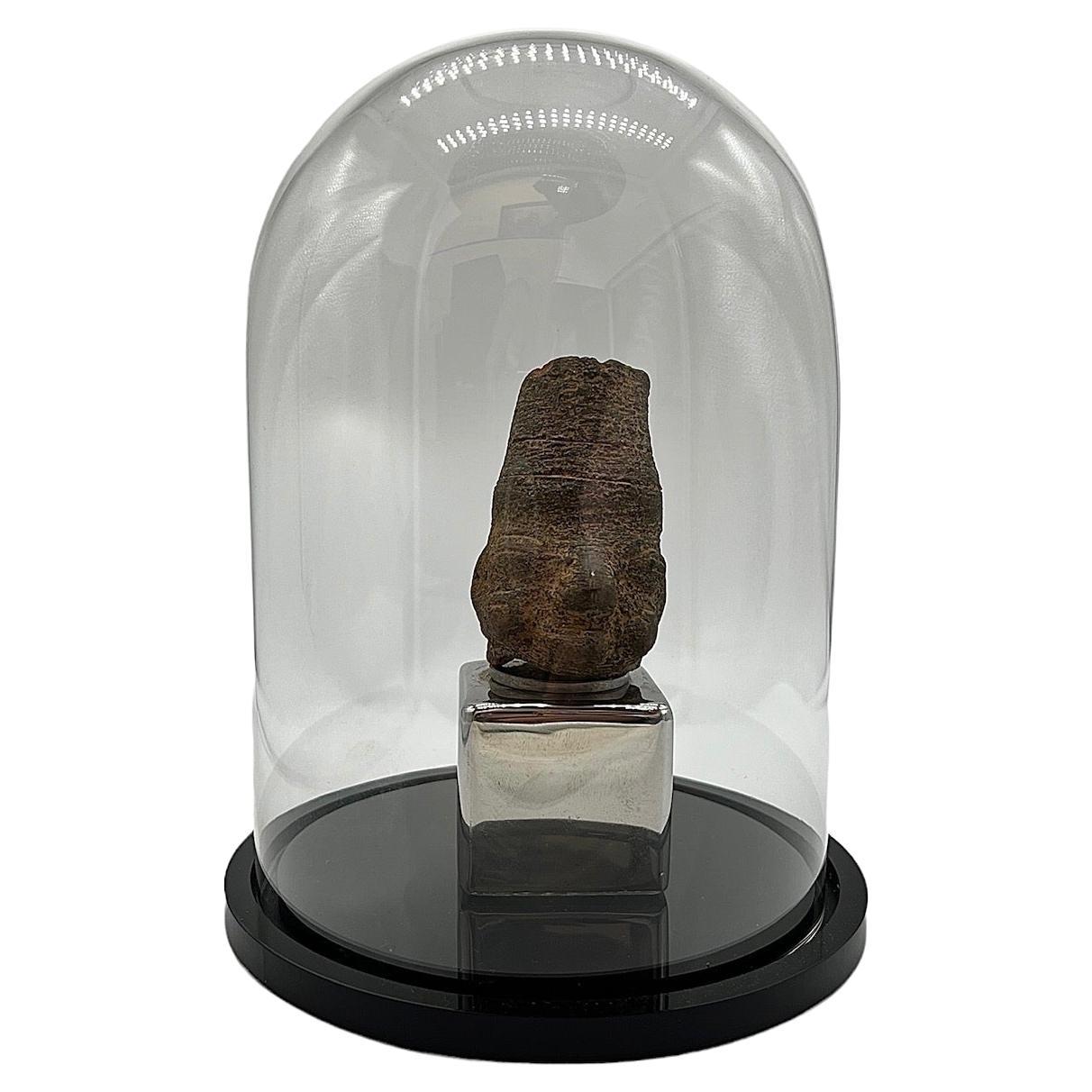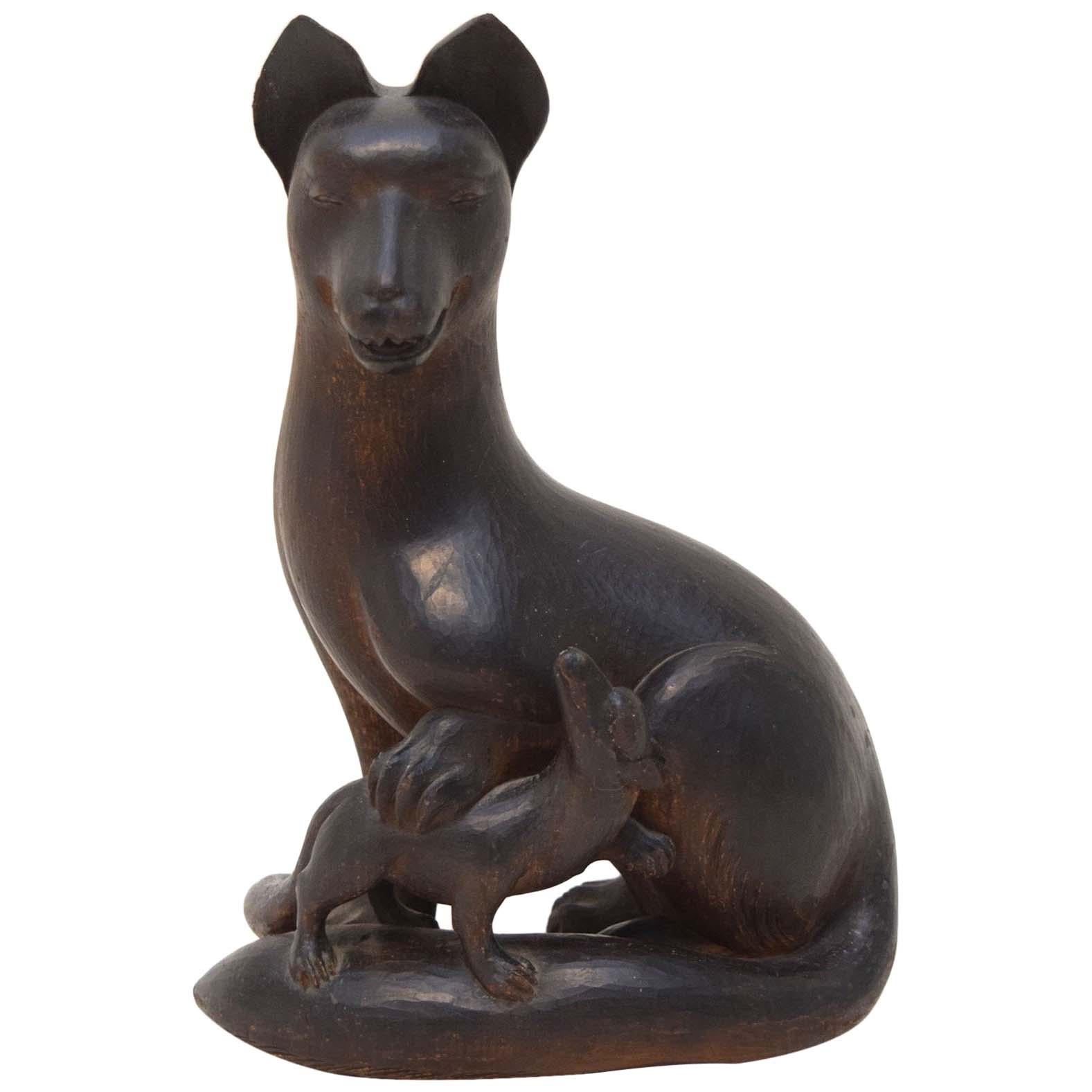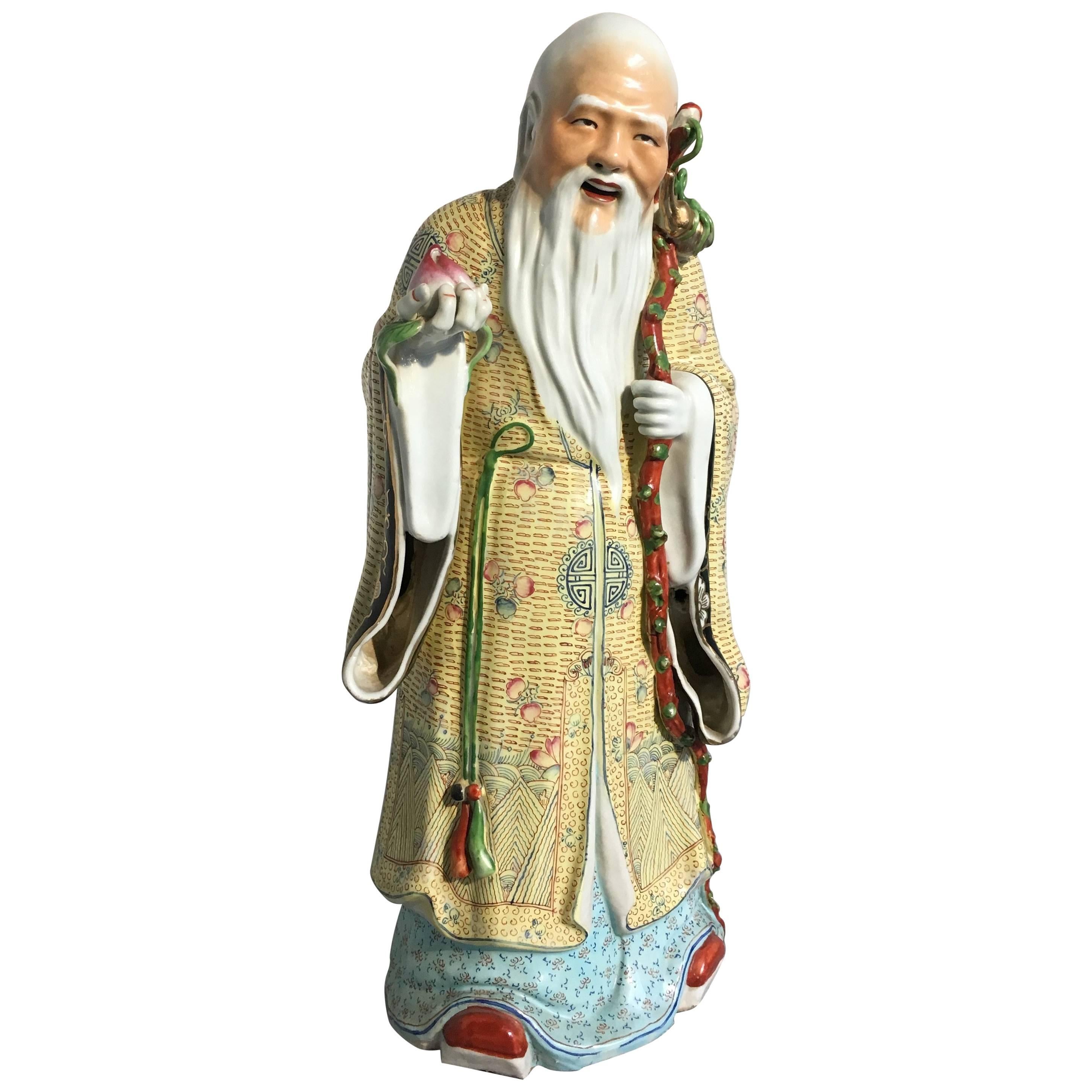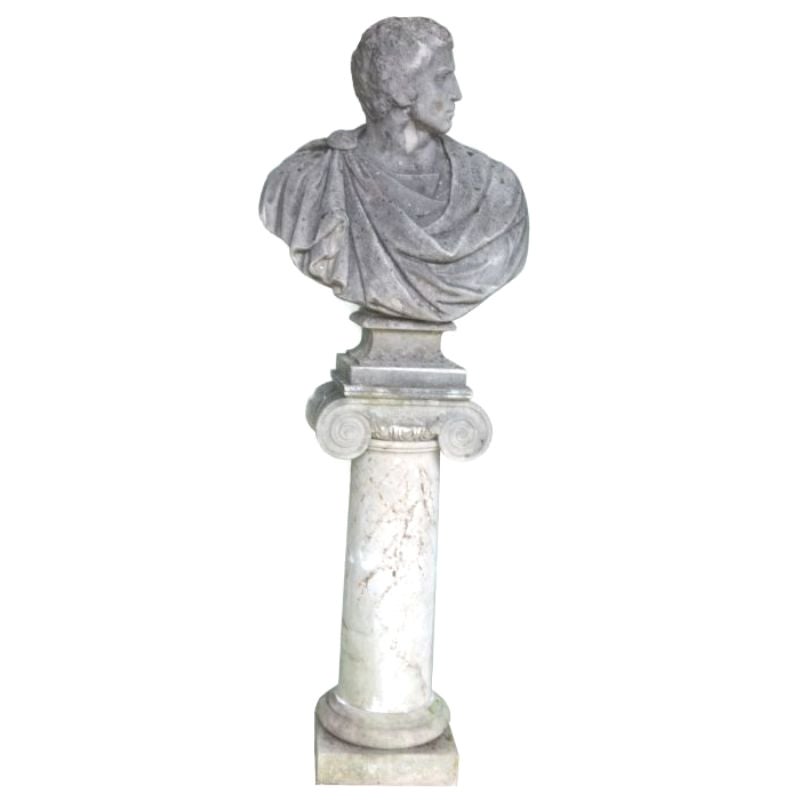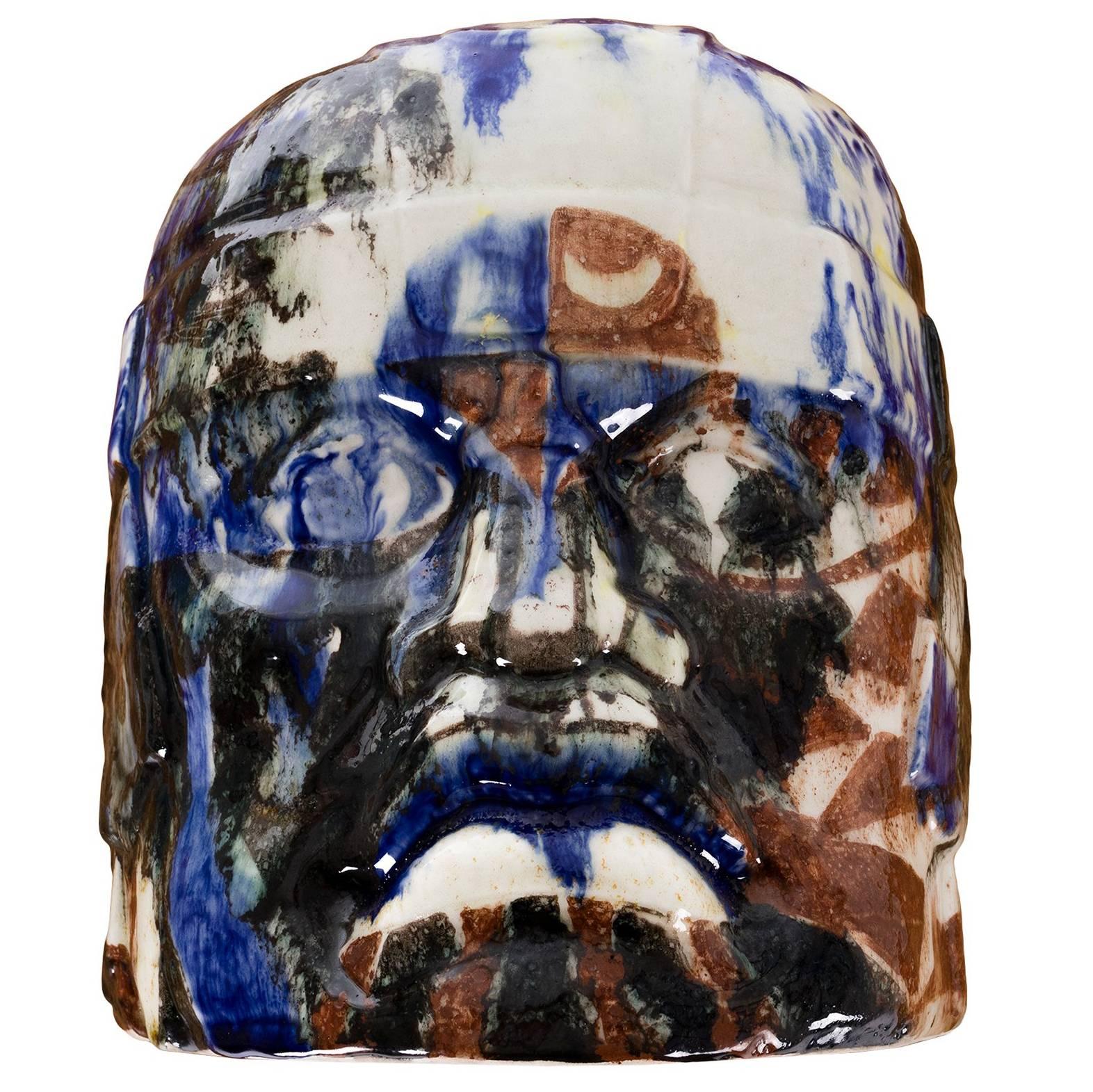Items Similar to Important Olmec figure of Olmec ethnic dignitary from the preclassic period
Want more images or videos?
Request additional images or videos from the seller
1 of 15
Important Olmec figure of Olmec ethnic dignitary from the preclassic period
About the Item
Important Olmec figure of Olmec ethnic dignitary from the preclassic period (2500-200 BC)
Important Olmec figure of dignitary of the Olmec ethnic group of the preclassic period (2500-200 BC)
Green serpentine, white, yellow veins, shiny surface.
Height 24.5 cm. Weight: 1446 g
Large character sculpted in a magnificent greenish blue serpentine veined with white. He is standing with his legs slightly bent. His arms hang along the trunk, the hands are represented with folded fingers closed by two straight thumbs. His heavy round shoulders are surmounted by a head with a prognathous chin, the lips drawn in the pure Olmec tradition (upper lip down). Two small, hollow, almond-shaped eyes surround a long, aquiline nose with flaring nostrils. On the sides, the presence of rectangular ears.
This statue is exceptional for its size, for the force that emerges from it and finally for its exceptional state of preservation. The Olmec civilization, more concerned with the gods than with men, is not characterized by representations of the human body. This excellently crafted anthropomorphic sculpture displays well-represented anatomical details. Therefore, we should not think that it is a free representation of the human body. On the contrary, it is almost certain that this piece was used in a ritual to represent a god or to attach the attributes of some deities such as necklaces or ornaments. It is dated to the Middle Preclassic for obvious stylistic reasons. This piece is an excellent example of Olmec stone art.
Among some of its physical characteristics, the following stand out: apparently “it had two fleshy bulges on the sides of the nose. The almond-shaped eyes are large and slightly oblique, with the outer corners down;
THE PEOPLE OF THE JAGUAR.
More than 3,000 years ago, between 1,200 and 400 B.C., Mesoamerica saw the rise and fall of the Olmec culture, one of the great civilizations of ancient Mexico. The Olmecs, “those who inhabit the land of rubber”, were capable of collecting and synthesizing the cultural patterns that had developed in the area for centuries. Even after the fall of its great centers, its achievements would be an important part of Mesoamerican culture.
Among the contributions that have led to the consideration of the Olmec as the "mother culture" of Mesoamerica are the first ceremonial buildings built according to a well-determined plan; the social structure, capable of organizing large works; the first and well-defined artistic style, embodied in small objects as well as in colossal sculptures; mastery of carving very hard stones; a fundamental ritual: the ball game; as well as the development of calendrical and writing systems.
The humid lands of southern Veracruz and western Tabasco were the setting where the Olmec culture expressed itself most intensely. Most of the known monumental sculpture—colossal heads, altars or thrones, stelae, and other stone-carved monuments—was found in that region. In a period of little more than 800 years (between 1200 and 400 B.C.), in this rich environment the most important Olmec sites that are known today arose, developed and finally decayed, such as San Lorenzo, Laguna de los Cerros, La Sale and Three Zapotes. Although the precise number of archaeological sites in the area is not yet known, the Olmec population density was quite high. Most of the populations were located on low hills or plateaus, close to rivers, which allowed immediate access to the fertile floodplains.
ORIGIN:
Acquired by the Valdivielso family in the 1960s.
Inherited to his children
Exhibitions:Grisalla Valladolid Art Gallery
BIBLIOGRAPHY.
Alcina Franch, Jose. ARCHAEOLOGISTS OR ANTIQUE DEALERS, Ancient History of Archeology in Spanish America, Ediciones del Serbal, 1995.
De la Fuente, Beatriz. "THE MEN OF STONE, OLMEC SCULPTURE", National Autonomous University of Mexico, Mexico, 1977.
Medellin Zenil, Alfonso. CORPUS ANTIQUITATUM AMERICANENSIUM, "Olmec monoliths and others in the museum of the University of Veracruz", National Institute of Anthropology and History, International Academic Union, Mexico, 1971.
Figures de Pierre, Paris, 1992, fig. 3, p. 31. Mezcala, Carlo Gay and Frances Pratt, Geneva, 1992, p. 213, fig. 253.
L'Art Précolombien, Olmèque, Maya, Aztèque, Lausanne, 1997, p. 76.
Mexico Terre des Dieux, Genève, 1998, p.34, plate 15.
Chontal, Ancient stone sculpture from Guerrero Mexico, Geneva, 2001, p. 109, plate n°164.
Au coeur de l'Amérique Précolombienne, 2003, p. 64, fig. 9. Catalog de la Vente Binoche, March 14, 2005, lot n°8.
Exhibition "Figures de Pierre, L'Art du Guerrero", Paris, 1992. Mexico, Terre des Dieux, Genève, 1998.
Museum of Anthropology of Xalapa, Veracruz. Mexico.
- Dimensions:Height: 2.76 in (7 cm)Width: 3.55 in (9 cm)Depth: 9.45 in (24 cm)
- Materials and Techniques:
- Period:
- Date of Manufacture:200
- Condition:
- Seller Location:Madrid, ES
- Reference Number:1stDibs: LU5779235213582
About the Seller
4.9
Platinum Seller
These expertly vetted sellers are 1stDibs' most experienced sellers and are rated highest by our customers.
Established in 2005
1stDibs seller since 2021
222 sales on 1stDibs
Typical response time: 1 hour
- ShippingRetrieving quote...Ships From: Madrid, Spain
- Return PolicyA return for this item may be initiated within 14 days of delivery.
More From This SellerView All
- Important Portuguese Oratory from the 17th CenturyBy Europa AntiquesLocated in Madrid, ESPortuguese Oratory from the 17th century, rosewood, internally sculpture in polychromatic and golden wood "The Virgin with the Child" Perfect cond...Category
Antique 17th Century Portuguese Baroque Figurative Sculptures
MaterialsWood
- Important Portuguese Oratory from the 18th CenturyBy Europa AntiquesLocated in Madrid, ESImportant Portuguese Oratory from the 18th century with a sculpture of Christ in gilded wood from the 18th century and two Saint Antony from the 17...Category
Antique Early 18th Century Portuguese Baroque Figurative Sculptures
MaterialsWood
- Important Pair of Cherubs in Carved, Gilded and Polychrome Wood from the 17th CLocated in Madrid, ESImportant Pair Of Cherubs In Carved, Gilded And Polychrome Wood From The 17th Century. It is of very good quality (see the work on the clothes). In very good conditions. The base is...Category
Antique 1680s Figurative Sculptures
MaterialsWood
- Guanyin Buddha in Meditation Chinese Sculpture from the Minguo PeriodBy Europa AntiquesLocated in Madrid, ESGuanyin buddha in meditation Chinese sculpture from the Minguo period (1912-1949) in bronze. Polychrome decoration. Dim.: 80 x 50 x 32 cm Good conditions.Category
Early 20th Century Chinese Chinese Export Figurative Sculptures
MaterialsBronze
- Important Portuguese Sculpture from the 17th Century, "Our Lady and Child Jesus"By Europa AntiquesLocated in Madrid, ESImportant Portuguese Sacred Art Sculpture from the 17th century, "Our Lady and Child Jesus" in polychromatic and gilded wood, It was never restored - m...Category
Antique 17th Century Portuguese Baroque Figurative Sculptures
MaterialsWood
- Important Sculpture Of The Apostle Saint John Of Veneto In ItalyLocated in Madrid, ESThis important sculpture of the apostle Saint John, originating from Veneto, Italy, portrays one of Jesus' closest and most beloved disciples. Saint John, also known as "The Beloved"...Category
Antique 16th Century Figurative Sculptures
MaterialsWood
You May Also Like
- Primitive Head Figure From the Pre-Columbian Period Made of StoneLocated in North Miami, FLIntroducing a remarkable artifact from the Pre-Columbian period—a primitive head figure intricately carved from stone. This ancient relic stands proudly...Category
Antique 15th Century and Earlier Pre-Columbian Figurative Sculptures
MaterialsStone
- Kitsune from the Edo PeriodLocated in New York, NYAccording to Japanese folklore the fox, or kitsune, can assume human form to protect and trick humble country folk. Dating to the 18th century, this fox protects its own pup. Carved ...Category
Antique 18th Century Japanese Sculptures and Carvings
MaterialsWood
- Chinese Republic Period Porcelain Figure of Shouxing, the God of LongevityLocated in Austin, TXA finely modeled Chinese porcelain figure of the Chinese God of Longevity, Shouxing, Republic Period, early 20th century, China. The God of Longevity, called Shouxing or Shoulao, stands upright holding a dragon staff in one hand, a peach (a symbol of immortality), in the other. He is dressed in a long yellow robe...Category
Early 20th Century Chinese Qing Sculptures and Carvings
MaterialsPorcelain
- Roman Dignitary SculptureLocated in Marseille, FRSoft stone sculpture representing a Roman dignitary from the 1900s on a stand with a column with a capital, 212 cm high for a tray size of 76 cm by 40 cm. Comes from the garden of a ...Category
Antique 19th Century Figurative Sculptures
MaterialsStone
- Pair of Fine Porcelains 'Couple Dignitaries'Located in Buenos Aires, ArgentinaPair of fine porcelains (couple dignitaries) circa 18th century origin Europe possible restoration in your hand (old) one of them has the letters L.G...Category
Antique Early 1900s European Neoclassical Figurative Sculptures
MaterialsPorcelain
- Olmec Head by Eric LedouxBy Eric LedouxLocated in Chicago, ILGlazed ceramic bust by Eric Ledoux. Born in Paris in 1946. Studied at Academy “Grande Chaumière” (drawing and composition). In 1968 he lead his own print workshop for the textile industry. During this time he worked with Pierre Cardin and Pierre Balmain. In 1968 he made his first trip to México to visit his uncle, renowned fashion designer Henri de Chatillon which would greatly impact his life. In 1989 Eric Ledoux along with his and his wife with his wife and his son permanently established their residence in México. His fascination with the colors, culture, and people are of constant inspiration often implementing bisque ceramics...Category
21st Century and Contemporary Mexican Brutalist Busts
MaterialsCeramic
